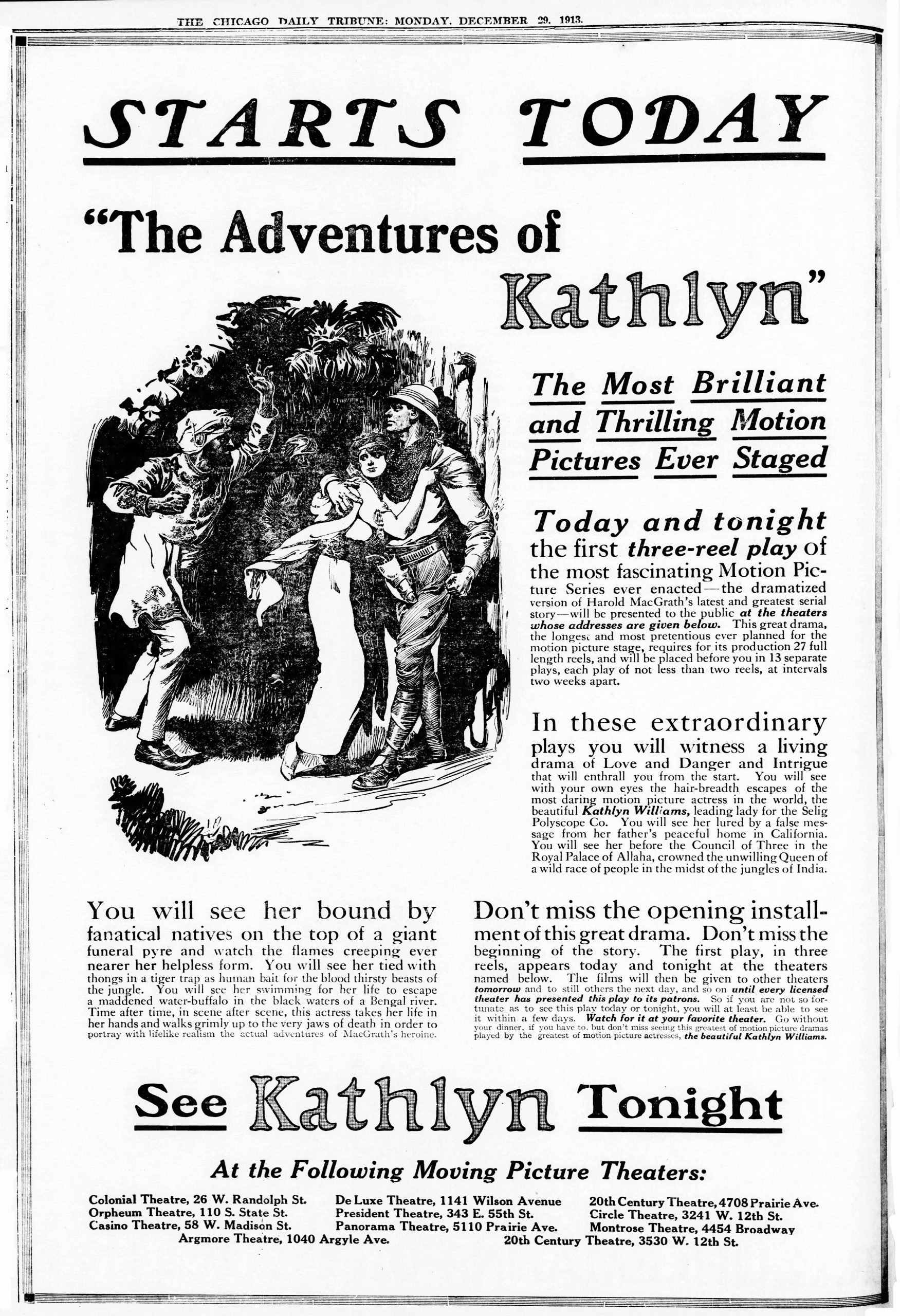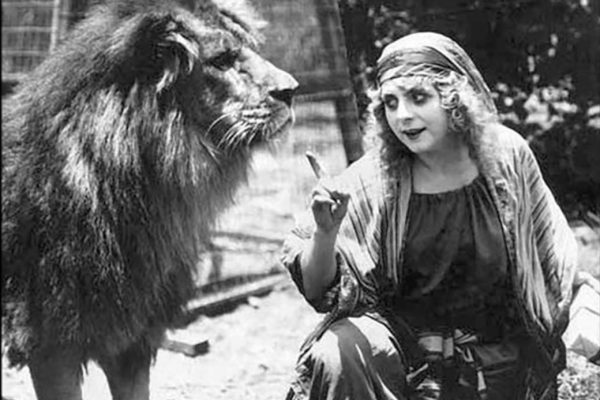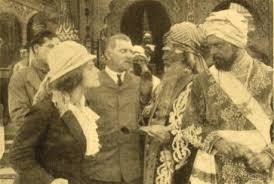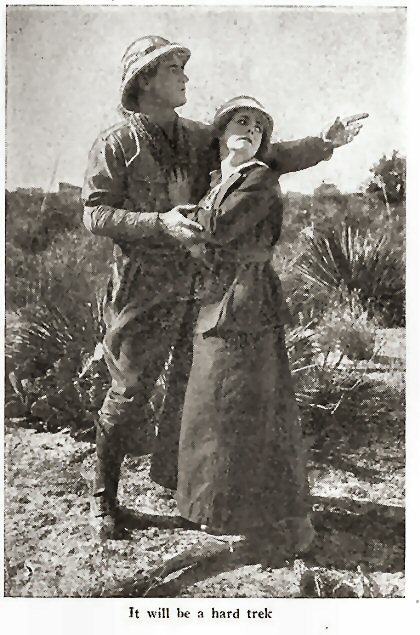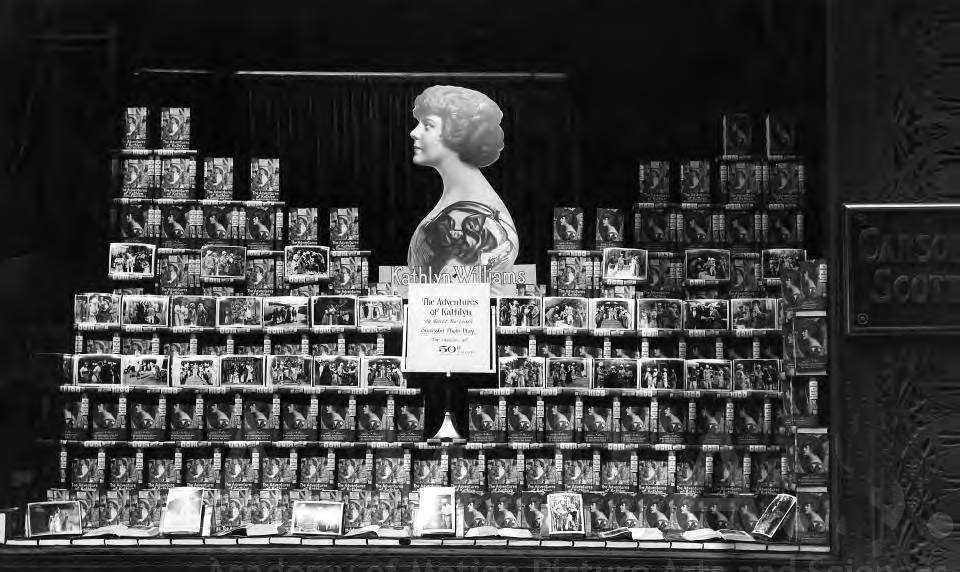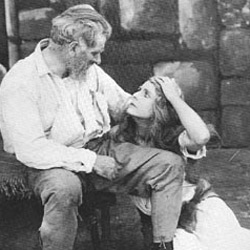A …is for
The Adventures of Kathlyn
Based on a story by Harold MacGrath with a screenplay by Gilson Willets, The Adventures of Kathlyn was produced in thirteen episodes, the first of which was released in theaters on December 29, 1913. New installments appeared at two-week intervals. At the same time, people could read a serialization of the stories in the Chicago Tribune (and later, according to Motography, in metropolitan newspapers “in every large city in the United States”), with a subsequent novelization of the complete episodes published in 1914. The promotion was an unqualified success: the Tribune enjoyed a ten per cent increase in circulation, a fact that was duly observed by other newspapers, including the Los Angeles Times, the New York Sun, the Boston Globe, and the Philadelphia Record, which soon established similar serial connections of their own. Selig also initiated other successful publicity gimmicks, such as the free distribution to all Photoplay magazine subscribers of a special edition of the MacGrath novelization, illustrated with stills from the film.
Unlike earlier series pictures, The Adventures of Kathlyn was an actual serial in which the stories were not self-contained but rather sequential, carrying the action over to the next installment. One of its defining elements (and a common element in subsequent serial productions) was the cliffhanger ending, which created what noted Pathé serial writer Frank Leon Smith termed a “holdover suspense.” That meant that the heroine was left hanging—sometimes literally—until the next episode, and so was the audience, who could only guess what the outcome of her adventure might be.
Starring as the daring Kathlyn was “The Selig Girl” Kathlyn Williams, an attractive young actress and former comedian who had studied at the American Academy of Dramatic Arts in New York City. Selig had already featured her in a number of one- and two-reelers that incorporated the impressive menagerie he amassed in his animal park just outside Los Angeles and often leased to other filmmakers. Newspapers predicted that the serial would be Selig’s most spectacular wild animal drama yet, with “the service of forty African lions, a herd of elephants, leopards, tigers and many other beasts of the desert and the jungle” as part of the new production’s “atmospheric effects.”
The popularity of The Adventures of Kathlyn, in fact, extended well beyond the episodes themselves and into the culture. Newspapers and magazines splashed Williams’ face on their covers, making it virtually impossible for people to pass a newsstand or shopfront without seeing her image. Couples danced to a hesitation waltz named in Kathlyn’s honor and sipped Kathlyn cocktails; women wore Kathlyn-style coiffures; and men carried souvenir postcards with her image. A song “Kathlyn, Dear Kathlyn” was published and performed, and Kathlyn’s name was used to promote products as diverse as slippers, face powders, and cigars. Kathlyn became one of the most popular names for babies, too—including a baby elephant. The serial even spawned a 1916 feature-length film that used the same cast and crew.
Most importantly, perhaps, The Adventures of Kathlyn introduced a “New Woman” type of heroine who was independent, ambitious, and engaging and who challenged traditional female roles. It also initiated a serial craze that would continue to fascinate moviegoers and filmmakers alike for decades to come.
Survival Status: The serial is considered lost. According to Progressive Silent Film List, a portion of episode one survives in the collection of La Cineteca del Friuli and a compilation of fragments in the EYE Film Instituut Nederland. The EYE has made a fragment available at YouTube/Courtesy of Eye Filmmuseum, Netherlands at https://www.youtube.com/watch?v=OCRmjKTYQfs.
Director: Francis J. Grandon
Release Date: December 29, 1913
Release Company: Selig Polyscope Company
Cast: Kathlyn Williams (Kathlyn Hare), Thomas Santschi (John Bruce), Charles Clary (Prince Umballah), William Carpenter (Ramabai), Goldie Colwell (Pundita), Hurri Tsingh (High Priest), Lafayette “Lafe” McKee (Colonel Hare), Effie Sackville (Winnie Hare), Roy Watson (Rajah), Franklyn Hall (Gundah Singh), C. J. Murphy (Boat Chief), Charles Courtwright (Council Member), Harry Huckins (Council Member), Edwin L. Wallock (Majordomo), Emma Bell, Edmund F. Cobb, Raymond Cannon.
Episodes: 1. The Unwelcome Throne (in three reels, with the rest of the episodes in two reels). 2. The Two Ordeals. 3. In the Temple of the Lion. 4. The Royal Slave. 5. A Colonel in Chains. 6. Three Bags of Silver. 7. The Garden of Brides. 8. The Cruel Crown. 9. The Spellbound Multitude. 10. The Warrior Maid. 11. The Forged Parchment. 12. The King’s Will. 13. The Court of Death.

